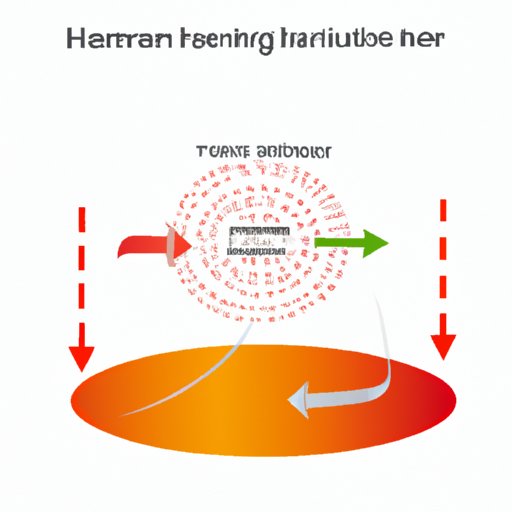I. Introduction
If you have ever felt the heat emanating from a radiator and wondered about the direction of heat transfer, you are not alone! Many people are curious about whether heat travels up or down. Heat transfer is a fundamental concept in physics and plays a crucial role in the functioning of heating and ventilation systems inside any enclosed space. In this article, we will explore the science of heat transfer, debunk common myths, and look at the implications of heat transfer for sustainable design.
II. The Science of Heat Transfer
Heat transfer refers to the movement of heat energy from one object to another as a result of a temperature difference. There are three main types of heat transfer: conduction, convection, and radiation. Conduction is the transfer of heat energy through direct contact between two objects, while radiation is heat transfer through electromagnetic waves. Convection is the transfer of heat through the movement of fluids.
Convection is responsible for the movement of heat in a vertical direction in an enclosed space. When air is heated, it rises upwards and displaces the cooler air above it, which then sinks down to the floor to replace the warm air. This circulation of air creates a convection current, which moves heat around the room.
For instance, when you turn on a heater in a room, the heat energy is transferred through convection, as the warm air rises and spreads to the cooler areas of the room. This process creates a natural convection current that moves the heat around the room.
III. Types of Heating Systems
There are several types of heating systems that are commonly used to heat a room, including radiant heating systems, forced air heating systems, and electric heating systems.
Radiant heating systems work by heating the objects in a room directly, such as through underfloor heating tubes or radiators. This system heats the objects closest to it first, which then radiates heat to the surrounding areas. In contrast, forced air heating systems work by blowing warm air through ducts that distribute the heat around the room.
Each type of heating system affects the direction of heat flow inside a room differently. Radiant heating systems distribute heat through conduction, where the heat energy moves from a warmer object to a cooler object, while forced air heating systems generate convection currents to distribute heat in a more uniform manner.
One of the key differences between radiant heating systems and forced air heating systems is their efficiency. Radiant heat systems tend to be more energy-efficient since they only heat the objects in the room and do not waste energy heating the air. In contrast, forced air heating systems can be less efficient since air leaks can occur in the ductwork, reducing the system’s overall efficiency.
IV. Myths about Heat Transfer
One common myth about heat transfer is that heat always rises. While convection currents do move warm air in an upward direction, where the heat flows ultimately depends on a variety of factors, such as the size of the room, the location of heat sources, and the layout of the room.
For example, if a room is poorly insulated, heat may escape through the walls and windows, regardless of whether it rises or falls. Moreover, the position of heat sources also plays a critical role in directing the flow of heat in a room.
Factors such as airflow, temperature, and humidity can impact heat flow in an enclosed space. For instance, a drafty room can cause heat loss through convection, while a room with high humidity can reduce the heat transfer rate through radiation.
V. Heating and Ventilation Q&A
One of the most frequently asked questions about heating and ventilation systems is whether it is more efficient to use a top-down or bottom-up approach for heating a room. In most cases, a bottom-up approach, such as a radiant heating system, is more efficient since it heats objects closer to the ground first, which then radiate heat to the surrounding areas.
Other practical tips for optimizing heating and ventilation systems in your home or office include using ceiling fans to distribute warm air, ensuring proper insulation, and regularly cleaning air filters to maintain the system’s efficiency.
VI. Scientific Research on Indoor Heat Transfer
Recent scientific research has shed light on our understanding of indoor heat transfer. Researchers have identified that factors such as furnishings, room layout, and surface temperatures can impact heat flow in an enclosed space.
Further research is needed to better understand the role these variables play in regulating indoor temperatures and creating a more comfortable and sustainable indoor environment.
VII. The Implications of Heat Transfer for Sustainable Design
Heat transfer is a crucial factor in sustainable design, where energy-efficient heating and ventilation systems are becoming increasingly important. Designers can enhance heating and ventilation systems by incorporating features such as proper insulation, air-tight seals, and energy-efficient glazing.
Moreover, designers can implement passive heating and cooling strategies, such as installing windows to maximize natural light and airflow to reduce the need for artificial lighting and air conditioning.
VIII. Conclusion
In conclusion, heat transfer is a complex phenomenon that plays a vital role in our understanding of indoor temperature regulation and in creating sustainable designs for the future. We have explored the science of heat transfer, debunked common myths, and provided practical tips for optimizing heating and ventilation systems in your home or office.
By implementing energy-efficient strategies and sustainable design principles, we can maximize the efficiency of our heating and ventilation systems while minimizing our environmental impact.
(Note: Is this article not meeting your expectations? Do you have knowledge or insights to share? Unlock new opportunities and expand your reach by joining our authors team. Click Registration to join us and share your expertise with our readers.)
